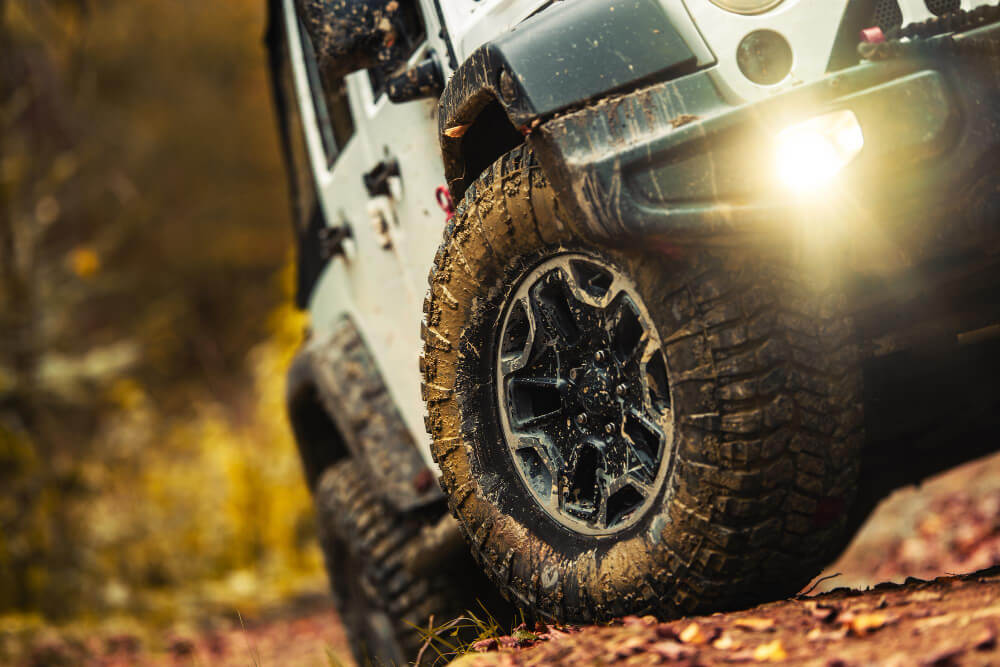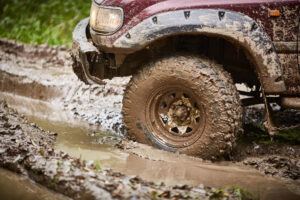The difference between an enjoyable off-road adventure and a frustrating ordeal often comes down to one crucial factor: tire pressure. As your tires meet different terrains across North Carolina’s diverse landscape, maintaining the right pressure becomes essential for both performance and safety.
At Agile Towing Company, we’ve rescued countless off-roaders who encountered difficulties due to improper tire pressure. If you happen to be in that same situation too, you can call us at (919) 276-5900. Our experience has taught us that understanding tire pressure management is crucial for any off-road enthusiast. For now, let’s get to know everything about managing tire pressure for different terrains.
Understanding Tire Pressure Basics
The relationship between your tires and the terrain is more complex than most drivers realize. PSI (Pounds per Square Inch) isn’t just a number on your tire gauge – it’s the key to how your vehicle interacts with the terrain beneath it.
While your vehicle’s manual specifies factory-recommended pressures, off-roading demands different approaches. Highway pressures typically range from 30-35 PSI, but off-road conditions often require significant adjustments.
Your tire pressure directly influences several crucial aspects of your vehicle’s performance:
- Traction and grip: Lower pressures increase the tire’s contact patch, improving grip on loose surfaces
- Vehicle stability: Proper pressure maintains consistent handling characteristics
- Fuel efficiency: Incorrect pressure can increase rolling resistance and fuel consumption
- Tire wear patterns: Uneven pressure leads to premature tire wear
- Overall safety: Maintaining appropriate pressure reduces the risk of tire failure
Understanding these relationships helps you make informed decisions when adjusting pressures for different conditions.
North Carolina Terrain Types and Pressure Guidelines
Sandy Coastal Trails
North Carolina’s coastal regions present unique challenges that require specific pressure adjustments. Lower tire pressures, typically between 12-15 PSI, allow tires to “float” better on sand by increasing the contact patch. However, never go below 12 PSI unless absolutely necessary, as this risks breaking the tire’s bead from the rim.
Key considerations for sandy terrain:
- Start with higher pressure and gradually reduce until achieving optimal flotation
- Monitor tire temperatures, as sand creates additional friction
- Consider tire width when selecting pressure – wider tires may need slightly higher pressure
- Maintain steady momentum to prevent sinking
Mountain Rock Trails
The western regions of North Carolina feature rocky terrain that demands a different approach to tire pressure. Higher pressures (18-22 PSI) help protect against sharp rocks and provide better stability on steep inclines. The firmer tire reduces the risk of punctures while maintaining enough flexibility to grip uneven surfaces.
Mountain trail pressure tips:
- Increase pressure when carrying heavy loads
- Adjust based on rock size and sharpness
- Consider tire construction type (radial vs. bias-ply)
- Monitor pressure changes with elevation gains
Muddy Piedmont Paths
Central North Carolina’s clay-rich soil creates notoriously slick conditions when wet. For muddy terrain, maintain pressures between 15-18 PSI. This range provides the optimal balance between traction and protection. The wider footprint helps prevent sinking while maintaining forward momentum.
Mud-specific considerations:
- Check pressure more frequently as mud can affect tire temperature
- Clean tires regularly to maintain proper pressure readings
- Adjust pressure based on mud consistency
- Consider seasonal variations in ground conditions
Essential Tire Pressure Equipment
Having the right tools makes pressure management easier and more precise. Here’s what you need in your off-road kit:
Quality Pressure Gauge
- Digital gauges offer precise readings (±0.5 PSI accuracy)
- Mechanical gauges provide reliable backup
- Choose gauges rated for off-road use
- Consider temperature compensation features
Portable Air Compressor
- Look for at least 150 PSI maximum pressure
- Consider duty cycle ratings for large tires
- Ensure adequate power connection options
- Check air flow rate capabilities (CFM ratings)
Tire Deflators
- Invest in both manual and automatic options
- Choose corrosion-resistant materials
- Consider ease of use in difficult conditions
- Look for precise adjustment capabilities
When and How to Adjust Pressure
Pre-Trail Inspection
Proper preparation prevents poor performance. Before hitting the trails:
- Check pressures when tires are cold
- Document starting pressures
- Inspect valve stems and caps
- Verify spare tire pressure
During Trail Adjustment
Trail conditions can change rapidly, requiring pressure adjustments:
- Stop completely before adjusting
- Make changes in small increments
- Test handling before proceeding
- Record successful pressure settings
Return to Highway Pressure
Transitioning back to paved roads requires careful attention:
- Allow tires to cool before final adjustment
- Return to manufacturer’s recommended pressure
- Check all tires for damage
- Monitor handling characteristics
Safety Considerations
Temperature and elevation changes significantly affect tire pressure – expect about 1 PSI change for every 10°F difference or 1,000 feet of elevation change. North Carolina’s varying landscape makes this especially relevant.
Common warning signs:
- Unusual handling characteristics
- Visible tire deformation
- Uneven wear patterns
- Decreased stability
- Excessive tire heat
Maintenance Tips for Off-Road Tires
Regular maintenance extends tire life and enhances safety. Establish a routine inspection schedule that includes:
Weekly Checks:
- Pressure verification
- Visual inspection for damage
- Wear pattern evaluation
- Valve stem condition
Monthly Inspections:
- Detailed tread examination
- Rotation assessment
- Balance check
- Alignment verification
Conclusion
Mastering tire pressure management transforms your off-road experience in North Carolina’s diverse terrains. Whether you’re tackling coastal sands or mountain trails, proper tire pressure ensures better performance and safety.
When things don’t go as planned in the Cary area, Agile Towing Company is here to help. Contact us at (919) 276-5900 for professional assistance. Remember, successful off-roading starts with proper preparation and understanding of your equipment.




